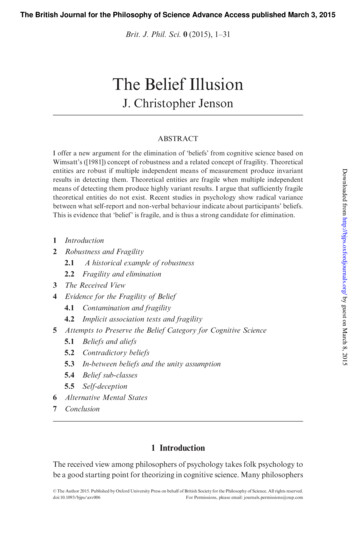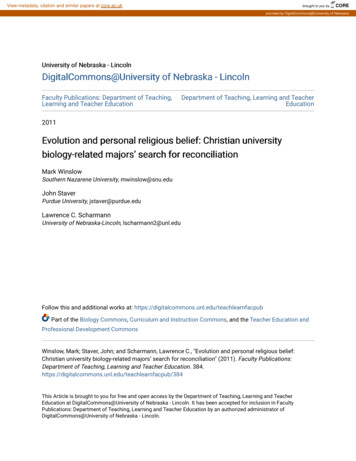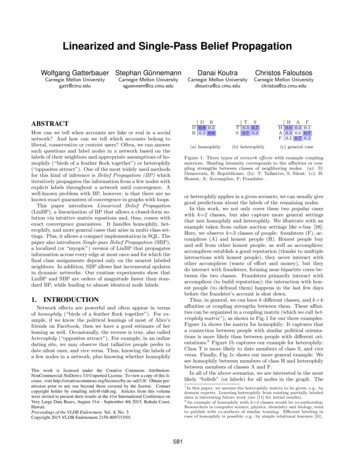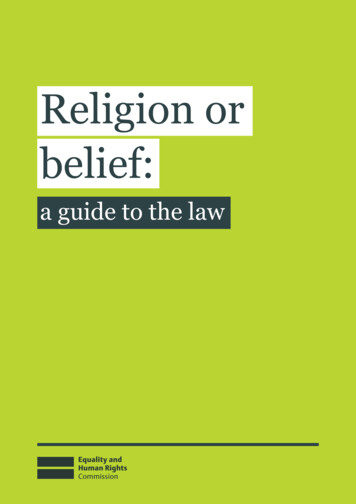
Transcription
The British Journal for the Philosophy of Science Advance Access published March 3, 2015Brit. J. Phil. Sci. 0 (2015), 1–31The Belief IllusionJ. Christopher JensonABSTRACT1234567IntroductionRobustness and Fragility2.1 A historical example of robustness2.2 Fragility and eliminationThe Received ViewEvidence for the Fragility of Belief4.1 Contamination and fragility4.2 Implicit association tests and fragilityAttempts to Preserve the Belief Category for Cognitive Science5.1 Beliefs and aliefs5.2 Contradictory beliefs5.3 In-between beliefs and the unity assumption5.4 Belief sub-classes5.5 Self-deceptionAlternative Mental StatesConclusion1 IntroductionThe received view among philosophers of psychology takes folk psychology tobe a good starting point for theorizing in cognitive science. Many philosophersß The Author 2015. Published by Oxford University Press on behalf of British Society for the Philosophy of Science. All rights reserved.doi:10.1093/bjps/axv006For Permissions, please email: journals.permissions@oup.comDownloaded from http://bjps.oxfordjournals.org/ by guest on March 8, 2015I offer a new argument for the elimination of ‘beliefs’ from cognitive science based onWimsatt’s ([1981]) concept of robustness and a related concept of fragility. Theoreticalentities are robust if multiple independent means of measurement produce invariantresults in detecting them. Theoretical entities are fragile when multiple independentmeans of detecting them produce highly variant results. I argue that sufficiently fragiletheoretical entities do not exist. Recent studies in psychology show radical variancebetween what self-report and non-verbal behaviour indicate about participants’ beliefs.This is evidence that ‘belief’ is fragile, and is thus a strong candidate for elimination.
2J. Christopher JensonDownloaded from http://bjps.oxfordjournals.org/ by guest on March 8, 2015(Botterill and Carruthers [1999]; Braddon-Mitchell and Jackson [2007]; Fodor[1987]; Sterelny [1990]) advocate taking folk psychological categories like‘beliefs’ and ‘desires’ to pick out real mental states. Jerry Fodor, for example,has been quite explicit in advocating the scientific vindication of folk psychology: ‘Holding onto the attitudes—vindicating common sense psychology—means showing how you could have [. . .] a respectable science whose ontologyexplicitly acknowledges states that exhibit the sorts of properties that commonsense attributes to the attitudes’ (Fodor [1987], p. 10). Fodor wrote this in themidst of a debate with eliminative materialists (Churchland [1981], [1986];Ramsey et al. [1990]; Stich [1983]) who argued that folk psychology is aradically inadequate theory. However, even at the height of this debate, eliminative materialism was always a minority view and received its death knellwhen Stephen Stich himself argued that eliminativism depends on whichtheory of reference is true, but variance in reference intuitions make it difficultto see which theory of reference is, in fact, true (Stich [1996]).There has been a surprising amount of resistance to the very idea of eliminativism even from philosophers who claim to have a naturalistic approach tophilosophy. The thought seems to be that folk psychology is so close to home,so essential to everyday use, that it could not be wrong. Or that if it is, thiswould be an unmitigated disaster. Fodor writes, ‘if commonsense intentionalpsychology really were to collapse, that would be, beyond comparison, thegreatest intellectual catastrophe in the history of our species’ (Fodor [1987],p. xii). It should not be surprising that our intuitions about how the worldworks are often wrong. The history of science consists of a string of counterintuitive results. For example, it is surprising to learn that the natural statefor an object is movement at a constant speed instead of being stationary.In chemistry, phlogiston theory was intuitive in part because it is natural tothink that when an object burns something leaves the object. It is surprising tolearn that something enters the object, namely, oxygen. In biology, it is naturalto think that offspring will have a blend of their parents’ traits. For example,if one parent has blond hair and another has brown hair, it is intuitive to thinkthat their offspring will have dishwater-blond hair or some other blend ofblond and brown. It took Mendel’s pea plant experiments and subsequentdiscoveries in genetics to find out that this is not how heredity works. LewisWolpert describes the nature of science as being ‘unnatural’ because it is socounter-intuitive: ‘I would almost contend that if something fits in withcommon sense it almost certainly isn’t science’ (Wolpert [1992], p. 11).This is what makes genuine scientific discoveries at once so difficult and soexciting. If common sense were a good guide to reality, we would not needscientific investigation.I propose that the eliminativists of the 80s and 90s (‘old school eliminativists’ hereafter) were on to something and that the issue deserves another look.
The Belief Illusion32 Robustness and FragilityFrom a common-sense perspective, how do you determine whether somethingis real? Imagine you are deep in the Sahara desert. You are out of water and12This claim is distinct from the claim made by simulationists (Goldman [1989]; Gordon [1986])that our ability to ‘mind-read’ or ‘mentalize’ is not explained by the existence of a tacit theory. Inthis article, I remain neutral about what the correct account of mind-reading might be.Lycan ([1988]) and Stich ([1996]) have pointed out that old school eliminativists argumentsassume that a description theory of reference is correct and will not go through without thatassumption.Downloaded from http://bjps.oxfordjournals.org/ by guest on March 8, 2015In this article, I offer a new argument for eliminating the mental category ofbelief from cognitive science. I am not arguing for the elimination of beliefsfrom everyday usage and I am not arguing for the elimination of all propositional attitudes as the old school eliminativists did. I restrict my argumenthere just to eliminating beliefs from cognitive science.One objection to old school eliminativist arguments is that they wronglytreat folk psychology as a quasi-scientific theory used to explain and predictbehaviour (Hannan [1993]; Wilkes [1993]).1 According to this view, folkpsychology does not treat beliefs and other propositional attitudes as discreteinner causes of behaviour, hence they are not candidates for elimination.One conclusion one might also draw from this is that it would be inappropriate to base cognitive science on the categories of folk psychology. While thesearguments might undermine old school eliminativism, they are compatiblewith the sort of scientific eliminativism I am advocating. I argue that beliefis not an appropriate category for cognitive science, but I have a very differentset of reasons for this conclusion. An alternative response to arguments likeHannan’s or Wilkes’s is to argue that we sharpen folk psychology up into ascientific theory, or at least use some folk psychological categories as the basisfor a scientific theory, even if folk psychology is not itself such a theory. Thisseems to be what Fodor has in mind when he argues for the vindication of‘commonsense psychology’ (Fodor [1985], [1987]). My argument in this articleis that this is still a bad idea in the case of belief. My argument avoids theproblematic reductive and semantic strategies that were employed by oldschool eliminativists.2 Instead, it is based on Wimsatt’s ([1981]) concept ofrobustness and the related concept fragility. I start by reviewing the notionsof robustness and fragility. Next, I review some assumptions about what constitutes a belief on the received view. Following that, I present a number ofstudies in psychology from the past forty years that provide evidence for thefragility of belief. These, I argue, make it a good candidate for elimination.Finally, I address a number of attempts to preserve belief as a scientificcategory.
4J. Christopher Jenson(1) Analyze a variety of independent derivation, identification, ormeasurement processes.(2) Look for and analyze things that are invariant over or identicalin the conclusions or results of these processes.(3) Determine the scope of the processes across which theyare invariant and the conditions on which their invariancedepends.(4) Analyze and explain any relevant failures of invariance.Wimsatt intends his concept of robustness to apply to a number of differenttargets, including theories, concepts, laws, models, processes, and objects.According to Wimsatt, any target that is invariant under this analysis is robust.Robustness analysis has come under some criticism (Justus [2012];Odenbaugh and Alexandrova [2011]; Orzack and Sober [1993]; Plutynski[2006]; Woodward [2006]). While a lengthy discussion of the putative confirmatory effects of robustness analysis would fall outside of the scope of this article,it is worth noting one reason why the cases of robustness analysis I focus onhold the promise of being defensibly confirmatory. Woodward ([2006]) distinguishes between several types of robustness. I will focus on just two of themhere. According to Woodward, inferential robustness involves applying multiple independent models, which make different and sometimes contrary idealizing assumptions, to a fixed data set in order to reach a conclusion about ahypothesis. Measurement robustness, on the other hand, consists of the agreement of multiple independent measurement or detection procedures. Most, ifnot all, of the criticisms of robustness analysis alluded to above are aimed atanalyses of inferential robustness. My argument is about the ontological statusDownloaded from http://bjps.oxfordjournals.org/ by guest on March 8, 2015would desperately like to get a drink. You see the shimmer of water in thedistance. Is it an oasis where you can fill your canteen or is it just a mirage?In this scenario, where all you have are your senses, you know that you cannotrely on vision alone. To confirm if there really is water in the distance,you must go up to it and feel its cool wetness. Your strategy is to use multiplemeans of detection to determine whether or not the water is real. Suppose youwant to determine if you have a glass of water in front of you or a glassof vodka. Since both water and vodka are clear liquids, you must smell thecontents of the glass and take a sip. Again you use multiple means of detectionto determine what is really the case.Following on the work of Campbell ([1958]), Campbell and Fiske ([1959]),and Levins ([1966], [1968]), William Wimsatt ([1981]) developed a concept ofrobustness based on the idea of using multiple independent means of detectionor measurement. According to Wimsatt ([1981], p. 126), robustness analysisinvolves the following procedures:
The Belief Illusion5of entities and categories; hence, I rely on the much more defensible notion ofmeasurement robustness. To the extent that an entity is robust, in this sense, wecan have confidence that it is real.2.1 A historical example of robustnessOur wonder is aroused at the very remarkable agreement found betweenthe values derived from the consideration of such widely differentphenomena. Seeing that not only is the same magnitude obtained by eachmethod when the conditions under which it is applied are as varied asmuch as possible, but that the numbers thus established also agree amongthemselves, without discrepancy, for all the methods employed, the realexistence of the molecule is given a probability bordering on certainty.(Perrin [1913], pp. 215–6)The basic argument is that it is incredibly unlikely that all of these independentmeans of measurement would produce such remarkable agreement about thenumber if it was not, in fact, the number of real molecules in the substancesmeasured. The results of multiple independent means of experimentalDownloaded from http://bjps.oxfordjournals.org/ by guest on March 8, 2015Wesley Salmon’s ([1984]) discussion of Jean Perrin’s argument for the existence of molecules is a helpful example of the relevant kind of robustnessanalysis. At the turn of the century, there was a great debate amongst scientistsabout the reality of molecules. Jean Perrin ([1913]) laid out a clear-cut argument in favour of their existence. The argument was based on the experimentaldetermination of Avogadro’s number, N—that is, the number of molecules ina mole of any substance. The thought was that if we could establish a way toactually count the number of molecules in a given quantity of substance, thenwe would, in effect, build a bridge between the microcosm and the macrocosm.Perrin used an ultramicroscope, which made it possible to observe particleswith diameters as small as 5 10 3 microns. At this magnification theBrownian movement of colloidal particles could be viewed, and Perrin wasable to base his determination of Avogadro’s number on observations of thevertical distribution of these particles in suspension. Perrin would go on todevelop two additional ways to determine Avogadro’s number based on whatwas known about Brownian motion.Subsequently, a number of independent experimental techniques weredeveloped to determine Avogadro’s number. Each of these techniques wassignificantly different from the others. Perrin counts thirteen different experimental techniques including those with a basis in Brownian movement, alphadecay, X-ray diffraction, blackbody radiation, and electrochemistry. Allthirteen produced practically the same number. Perrin put particular emphasison the number of independent means of detection that were used. Salmon([1984]) quotes Perrin’s account:
6J. Christopher Jensondetection of Avogadro’s number were mostly invariant across a number ofdifferent substances. Thus, the evidence for Avogadro’s number is robust.It was these arguments that convinced scientists who were sceptical of theexistence of molecules that they were mistaken and that molecules were,in fact, real.2.2 Fragility and eliminationDistinguishable qualities of character, e.g., ‘autonomy’ and ‘ascendancy’,typically show higher within method associations than parallel acrossmethod associations. For example, if ‘autonomy’ and ‘ascendancy’ aremeasured using two methods, a projective test (e.g., T.A.T.) and a clinicalinterview, ‘autonomy’ and ‘ascendancy’ will more positively correlate3Leamer ([1983]) uses the term ‘fragility’ in a similar, but different way. Leamer’s notion appliesto inferential robustness, rather than measurement robustness. For Leamer, if multiple modelslead to quite different conclusions, then inference to the conclusion is fragile and suspension ofbelief in that conclusion is recommended. I argue that measurement fragility gives us positivereason to think an entity does not exist. Measurement fragility is more like a rebutting defeaterthan an undercutting defeater in the sense of Pollock ([1986]).Downloaded from http://bjps.oxfordjournals.org/ by guest on March 8, 2015Robustness analysis can also give us a useful eliminativist tool. There is auseful inverse of the concept of robustness: fragility. A theoretical entity isfragile if the results of multiple, independent, putatively reliable measures ofthat entity turn out to radically vary and this variation cannot be adequatelyexplained away. If our theories posit an entity or process as real, thenwe should expect the detection of that entity, ceteris paribus, to be fairlyrobust. That is to say, one would expect the results of various methods ofmeasurement or detection of the entity to produce invariant results. When thedetection of an entity or category is robust or fragile, I will call it a robust orfragile entity. If an entity turns out to be sufficiently fragile, then we havereason to think the entity is not real.3 If Perrin had gotten variant resultsacross different experimental techniques, it would have been rational for hiscontemporaries to be much less confident in the existence of molecules.Furthermore, given that the existence of molecules was controversial at thetime, it would have been reasonable to think that it is more likely that they donot exist than it would be to suppose that something had gone wrong with theexperiments.In his discussion of robustness, Wimsatt cites a series of papers on cultureand personality theory as a good detailed example of a failure to meet the requirements of robustness (Shweder [1979a], [1979b], [1980]). Shweder presentsevidence that global personality traits such as being introverted or extrovertedare highly context dependent. The following passage is typical of the typeof evidence he presents:
The Belief Illusion7within the projective test data than ‘autonomy’ correlates with itselfacross the two methods. In general, features of personality measuringinstruments (the clinical interview situation, the projective test stimulusand context) have been found to be more stable than the features of thepeople measured. (Shweder [1979a], p. 259)The more assertive child at the breakfast table is not the more assertivechild in the playroom. The child who seeks help more than others is notthe one who is more inclined to seek physical nearness [. . .] The adultwho is more hostile to a parent is not typically the adult who ismore hostile to a boss, nor is he or she the one who is typically lesshostile to a boss. Individual differences in one context do not predictindividual differences in the other. Different situations, stimuli ordomains seem to affect different people differently. (Shweder [1979a],p. 260)When psychologists attempt to detect these global personality traits in anumber of different circumstances, they get highly variable results. This ismore evidence that these global personality traits are fragile. Shweder findsthe lack of evidence for global traits surprising because they are a part of ourcommon-sense understanding of psychology:The absence of impressive support for generalized or global traits ofcharacter is surprising. Most of us, social scientist and layperson alike,share certain intuitions or everyday personality theories which suggestthat certain items or traits of behavior go together (e.g., ‘smiles easily’and ‘introduces himself to strangers’; ‘gentle’ and ‘good-natured’) or areopposed (e.g., ‘aggressive’ and ‘friendly’; ‘gregarious’ and ‘reserved’)(see Brown [1965]; D’Andrade [1974]). Many personality psychologistsand most laypersons interpret these ‘everyday’ personality theoriesor trait and type concepts as inductive generalizations. They are held toarise out of observational experience and accurately summarize orencode ‘relative frequencies of joint occurrences of various personalityattributes and behavioral dispositions in other persons’ (Passini andNorman [1966]; also, see Brown [1965]). Recent evidence, however,challenges this view. (Shweder [1979a], p. 262)Downloaded from http://bjps.oxfordjournals.org/ by guest on March 8, 2015So, instead of finding invariant results across different measures of‘autonomy’, it is typical to find variable results. In this case, ‘autonomy’turns out to be fragile, and so we do not have much confidence that thereis such a personality trait, at least not as a global personality trait that generalizes across a number of contexts. This is essentially the argument Shwedermakes. Most of the evidence he presents follows the same pattern. He takesthe variability across different measures of personality traits to rebut theirevidential support.For example, on a number of hypothesized global trait dispositions like‘dependency’, ‘dominance’, or ‘friendliness’, Shweder presents evidence ofhigh variability across contexts. Shweder describes this variability as follows:
8J. Christopher Jenson3 The Received ViewConsidering the central role folk psychology realists advocate for beliefs,4 theyhave been surprisingly sparse in their account of what it is to believe something. On their view, beliefs can be individuated from other mental states bythe causal role they play in the architecture of the mind.5 One very clear andhelpful description of the functional architecture of the mind in this traditionis one proposed by Shaun Nichols and Stephen Stich ([2003]). Figure 1 is arepresentation of this architecture.45Following Botterill and Carruthers ([1999]), I mean to contrast those who argue that the categories of folk psychology are scientifically real with those such as Dennett ([1987]) who treatthem as useful fictions for prediction. Fodor gives the following useful definition: ‘I propose tosay that someone is a Realist about propositional attitudes iff (i) he holds that there are mentalstates whose occurrences and interactions cause behaviour and do so, moreover, in ways thatrespect (at least to an approximation) the generalizations of common-sense belief/desire psychology; and (ii) he holds that these same causally efficacious mental states are also semanticallyevaluable’ (Fodor [1985], p. 78).Ramsey ([2010]) has pointed out that the functional role of beliefs individuates them fromdesires and the other attitudes, but does not tell us their functional role qua representations.Downloaded from http://bjps.oxfordjournals.org/ by guest on March 8, 2015The case that can be made for the fragility of global personality traits parallelsthe case I am trying to make for beliefs. Both beliefs and personality traits aretaken for granted by the folk, but both turn out to be fragile when measuredunder experimental conditions. In fact, Campbell and Fiske ([1959]) arguethat very few posits in the social sciences have ‘convergent validity’, a conceptvery much like Wimsatt’s robustness. They argue that this is a majordifference between the social and biological sciences. It is the source ofmany problems in the social sciences. Contra Shweder, we should expectthat many folk psychological concepts would fail to have good evidentialsupport.The elimination of phlogiston can be understood in terms of fragility aswell. According to phlogiston theory, combustible substances are combustiblebecause they contain phlogiston and phlogiston is released when they burn.So, when a substance is burned, it should lose mass. This is precisely what wasfound when substances like wood were burned and their ashes weighed.However, when metals were burned the mass of the metal increased ratherthan decreased. These are radically variant results across two distinct attemptsto detect phlogiston. One substance’s mass increased and one substance’smass decreased. Phlogiston theory also predicts that, if a substance isburned in a bell jar, the volume of air in the jar should increase because thephlogiston is being released into the air. When wood is burned this is indeedwhat you find. However, when metal is burned, the volume of air in the jardecreases. Again, there is wild variation in results. This sort of fragility is whatyou would expect when trying to measure something that does not exist.
9The Belief IllusionBasic Cognitive n-making(practical reasoning)systemOther desiregenerating systemsAction controlsystemsBehaviorFigure 1. The basic architecture of the cognitive mind (Nichols and Stich [2003])redrawn by Stephen Downes.According to Nichols and Stich, to have a belief that P is to have a tokenrepresentation with the content P in the ‘belief box’. Some philosophers in thistradition require that these representations must be in a quasi-linguisticformat (Botterill and Carruthers [1999]; Fodor [1975], [1987]; Sterelny[1990]). This is by no means universal: many prominent philosophers in thistradition, including Nichols and Stich, are not committed to quasi-linguisticrepresentation and propose various alternatives (Braddon-Mitchell andJackson [2007]; Dretske [1991]; Lewis [1994]; Nichols and Stich [2003]). Theimportant feature to notice in Nichols and Stich’s model, for my purposes, isthat it has only one belief box. This means that if a mental state does notplay the functional role indicated for the belief box, then it is not a belief.This severely restricts the number of sub-types of belief that are possible,if indeed folk psychology allows for any. There being just one belief boxindicates an assumption that beliefs constitute a single, unified categoryof mental states. This is a nearly universal assumption amongst folk psychology realists. Keith Frankish ([2004]) has called this ‘the unity of beliefassumption’.Another helpful account of folk psychology comes from Brian Loar([1981]). Eric Schwitzgebel has helpfully summarized Loar’s account intofour important functional roles played by beliefs:(1) Reflection on propositions (e.g., [Q] and [if Q then P]) fromwhich P straightforwardly follows, if one believes those propositions, typically causes the belief that P.Downloaded from http://bjps.oxfordjournals.org/ by guest on March 8, 2015Re-drawn from Nichols& Stich (2003)
10J. Christopher Jenson(2) Directing perceptual attention to the perceptible properties ofthings, events, or states of affairs, in conditions favorable toaccurate perception, typically causes the belief that thosethings, events, or states of affairs have those properties (e.g.,visually attending to a red shirt in good viewing conditions willtypically cause the belief that the shirt is red).(3) Believing that performing action A would lead to event or stateof affairs E, conjoined with a desire for E and no overridingcontrary desire, will typically cause an intention to do A.It is clear from this that there are two basic means of detecting what a personbelieves. Function (4) fits with the common-sense idea that if you want toknow what someone believes, ceteris paribus, you should listen to what theysay they believe. Function (3) suggests we can often use a person’s non-verbalbehaviour to determine what they believe. This is consistent with the commonrefrain that ‘actions speak louder than words’. Of course, there are manydifferent ways we might use these types of belief detection, but togetherthey exhaust all possible means currently available for objectively detectingbeliefs. I now turn to some research in social psychology that shows that if wetreat beliefs as a unified category, then these methods of detecting beliefsproduce wildly variable results.4 Evidence for the Fragility of BeliefResearch in psychology has consistently produced evidence that beliefs arefragile. That is to say, different means of detecting a person’s beliefs vary tothe point of contradiction. One classic example of this comes from Nisbett andWilson ([1977]). They presented study participants with four pairs of identicalnylon stockings laid out in a line. The participants, who were not told that thenylon stockings were identical, were asked which of the nylon stockings theyliked best. The participants made their choices. When they were asked whythey chose a particular pair, participants generally explained their choicesin terms of some property or another such as colour, texture, or shape.The reasons given by the participants could not actually explain their choicesbecause all of the nylon stockings were identical. Participants consistentlychose the pair on the far right-hand side. There is no reason to think thatthe heuristic ‘choose the one on the right’ could make the nylon stockings onthe right seem better in terms of its qualities. The heuristic was operating in theDownloaded from http://bjps.oxfordjournals.org/ by guest on March 8, 2015(4) Believing that P, in conditions favoring sincere expressionof that belief, will typically lead to an assertion of P.(Schwitzgebel [2011]).
The Belief Illusion114.1 Contamination and fragilityMore evidence for the fragility of belief comes from Paul Rozin’s work oncontamination. In a well-known study, participants were presented with asweater, which they were told was owned by Adolf Hitler (Nemeroff andRozin [1994]). Participants refused to wear the sweater, even after beingtold it had been thoroughly washed. This behaviour would indicate that thetest participants believed that the sweater is tainted with evil and that theymight be contaminated by it. If asked if this is what they really believe, at leastsome participants are likely to say no. In another study, participants are askedto eat fudge shaped to look like dog faeces, drink lemonade served in asterilized bedpan, and to throw darts at a picture of a loved one (Rozinet al. [1986]). Not surprisingly, participants were reluctant to do so. Theirbehaviour would indicate that they believe that the fudge is dog faeces, theDownloaded from http://bjps.oxfordjournals.org/ by guest on March 8, 2015absence of any distinguishing properties other than position relative to theother nylon stockings. It is likely that position determined the participants’choices and not features of the nylon stockings themselves.This study naturally raises the question of whether study participants reallybelieved the nylon stockings were different. According to Nisbett and Wilson,the subjects reported their reasons for making their selections sincerely. So, ifwe use what people verbally report as a good means of detecting their beliefs,as Loar’s fourth functional individuating condition indicates it should be, weshould think that they really did believe that the nylon stockings are different.However, their behaviour—picking the nylon stockings on the right—indicated that they did not believe the nylon stockings are different. Behaving asthough P is, ceteris paribus, a good reason for thinking a person believes that Pjust as Loar’s third functional individuating condition says it should be. Ifparticipants believed that the nylon stockings were all the same, it would havebeen natural to use a heuristic like, ‘choose the one on the right’. In this case itis also worth noting that there is a tensio
This is evidence that 'belief' is fragile, and is thus a strong candidate for elimination. 1 Introduction 2 Robustness and Fragility 2.1 A historical example of robustness 2.2 Fragility and elimination 3 The Received View 4 Evidence for the Fragility of Belief 4.1 Contamination and fragility 4.2 Implicit association tests and fragility










